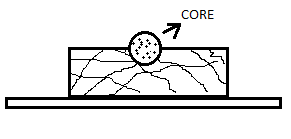This set of Casting Questions and Answers for Experienced people focuses on “Baking the Cores”.
1. Which of the following equipment is used for both limited and mass production?
a) Core ovens
b) Dielectric bakers
c) Radiant bakers
d) Flame bakers
View Answer
Explanation: Core ovens are the equipment which can be used for the making of limited productions. It is also a good choice if the production is going to be a mass one.
2. After preparation of cores, cores on the core plates are sent for what?
a) Pressurizing
b) Baking
c) Increasing the volume
d) Decreasing the volume
View Answer
Explanation: Baking is a process that takes place after quite a lot of preliminary operations. After the cores are prepared, the cores are then placed on the plates and moved forward for baking.
3. What does the following figure represent?

a) Core plate
b) Core drier
c) Core oxidizer
d) Core rack
View Answer
Explanation: The given figure is a core drier. It is a wooden piece which is having a semi circular groove used for supporting a round core.
4. Cores are baked up to what temperature?
a) 600°F
b) 650°F
c) 700°F
d) 750°F
View Answer
Explanation: Before the beginning of the process, the cores need to be taken to a decently good amount of temperature by preheating them. While baking the cores, the cores are taken up to a temperature as high as 650°F.
5. The moisture of the core is taken off during baking at what temperature?
a) 197°F
b) 212°F
c) 278°F
d) 304°F
View Answer
Explanation: None.
6. Core oil and binders change their chemical properties at what temperature?
a) 200°F – 300°F
b) 300°F – 400°F
c) 400°F – 500°F
d) 500°F – 600°F
View Answer
Explanation: Whenever any material is heated to a temperature high for its properties, there is a change in its chemical and physical aspects seen. Core oils and organic binders used in backing the core, change their physical properties at 400°F – 500°F.
7. What does an unbacked core generate?
a) Greenhouse gases
b) Mold gases
c) Mold liquids
d) Ultraviolet rays
View Answer
Explanation: An unbacked core causes to generate an excessive amount of mold gases which then produce blowholes in the castings.
8. Using what are core ovens heated?
a) Gases or oils
b) Infrared heating
c) Ultraviolet heating
d) Solar heat
View Answer
Explanation: Core ovens are heated in a well-defined temperature range. They are heated using gases and other oils.
9. Drawer type core ovens are used for baking large sized cores.
a) True
b) False
View Answer
Explanation: Drawer type core ovens are used for baking small sized cores. These types of core ovens need proper fuel to be able to energize it to work, hence, they use gas or oil-fuels.
10. Which of the following type of air is circulated over rack type core oven?
a) Cool air
b) Hot air
c) Compressed air
d) Odourless air
View Answer
Explanation: On a rack type core oven, for proper baking of the core, hot air is circulated over the cores. Odourless air or compressed air or cool air cannot be of much help here.
Sanfoundry Global Education & Learning Series – Casting.
To practice all areas of Casting for Experienced people, here is complete set of 1000+ Multiple Choice Questions and Answers.
If you find a mistake in question / option / answer, kindly take a screenshot and email to [email protected]
- Apply for Mechanical Engineering Internship
- Check Mechanical Engineering Books
- Practice Casting, Forming and Welding II MCQ
- Practice Metallurgical Engineering MCQs
- Practice Mechanical Engineering MCQs
